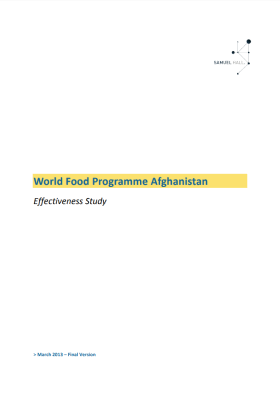World Food Programme Afghanistan: Effectiveness study
This document presents the findings of a comparative cost effectiveness analysis of four WFP hunger reduction activities. It can be seen as a follow up on the Country Portfolio Evaluation 2012. This study has been conducted using the existing WFP operational costing data and assessing costs benefits through an analysis of data gathered at the regional and provincial levels. Through the review of existing information extracted from WFP Afghanistan and Samuel Hall databases and the comprehensive field survey of 10 provinces by Samuel Hall teams, the review team aims to provide WFP Afghanistan with a socio-economic assessment of the positive and negative outputs and outcomes of its food relief and assistance activities – limited to, education related food assistance, health related food assistance, literacy and skills development related food assistance and food for assets interventions. The final cost effectiveness analysis presents the: 1) positive and negative; 2) short and long term; 3) direct and indirect; 4) social and economic outputs of WFP activities through a reality check that crosses the analytical model with the practical case studies developed in beneficiary districts.
The objective of this study is not to evaluate the respective cost effectiveness of each of the WFP sub programmes in Afghanistan, as it may lead to hasty conclusions – depending on the criterion of reference(long or short term, social or economic impact, etc.) and the size or volume of a project (significant economies of scale can be made between the pilot and a nationwide phases of a project). Rather, the evaluation team questioned some of the key assumptions of both WFP relief and recovery activities, through an assessment of their actual socio-economic impact on the lives of beneficiaries. To do so, the review team used the data collected in ten provinces, in 2011 and 2012, among four distinct types of WFP beneficiaries to compare them with control groups randomly selected in the same provinces. Three core activities (FFA, FFT and FFW), using food distribution exclusively, as well as one specific transfer modality (Cash Vouchers) were assessed during this 2-year evaluation. Overall, a total of 4,012 households were interviewed in the provinces of Badakhshan, Balkh, Faryab, Herat, Jawzjan, Kabul, Kandahar, Kunduz, Nangarhar, and Samangan.



